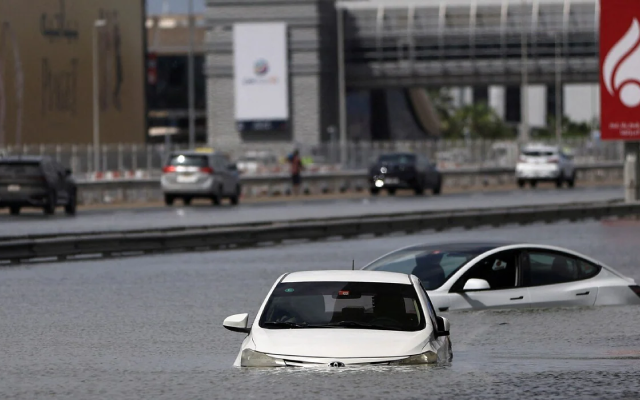This week, a storm that brought record-breaking rainfall to the United Arab Emirates and Oman flooded houses, gridlocked traffic, and trapped people inside their homes.
There were reports of at least 20 fatalities from the floods in Oman, and one death from floods in the United Arab Emirates, which caused government buildings and educational institutions to close for several days.
Before it pummeled the UAE on Tuesday, the storm had first struck Oman on Sunday. It caused power outages and severely disrupted travel, turning runways into rivers.
In the UAE, a record 254 millimetres (10 inches) of rainfall was recorded in Al Ain, a city bordering Oman. It was the largest ever in a 24-hour period since records started in 1949.
Did Cloud Seeding Cause The Storm?
Rainfall is rare in the UAE and elsewhere on the Arabian Peninsula, that is typically known for its dry desert climate. Summer air temperatures can soar above 50 degrees Celsius.
But the UAE and Oman also lack drainage systems to cope with heavy rains and submerged roads are not uncommon during rainfall.
Following Tuesday’s events, questions were raised whether cloud seeding, a process that the UAE frequently conducts, could have caused the heavy rains.
Cloud seeding is a process in which chemicals are implanted into clouds to increase rainfall in an environment where water scarcity is a concern.
The UAE, located in one of the hottest and driest regions on earth, has been leading the effort to seed clouds and increase precipitation.
But the UAE’s meteorology agency told Reuters there were no such operations before the storm.
What About Climate Change?
Experts say that the massive downpour was most likely caused by a typical weather pattern that was made worse by climate change.
Senior forecaster Esraa Alnaqbi of the UAE government’s National Centre of Meteorology said that low pressure at the surface combined with a low pressure system in the upper atmosphere had created a “squeeze” on the air pressure.
The strong thunderstorm was brought about by this squeeze, which was exacerbated by the difference in temperature between the ground and higher elevations.
The “abnormal phenomenon” was not unexpected in April as when the season changes the pressure changes rapidly, she said, adding that climate change also likely contributed to the storm.
Climate scientists say that rising global temperatures, caused by human-led climate change, is leading to more extreme weather events around the world, including intense rainfall.
“Rainfall from thunderstorms, like the ones seen in UAE in recent days, sees a particular strong increase with warming. This is because convection, which is the strong updraft in thunderstorms, strengthens in a warmer world,” said Dim Coumou, a professor in climate extremes at Vrije Universiteit Amsterdam.
Can’t Create Clouds From Nothing
Friederike Otto, a senior lecturer in climate science at Imperial College London, said rainfall was becoming much heavier around the world as the climate warms because a warmer atmosphere can hold more moisture. It was misleading to talk about cloud seeding as the cause of the heavy rainfall, she said.
“Cloud seeding can’t create clouds from nothing. It encourages water that is already in the sky to condense faster and drop water in certain places. So first, you need moisture. Without it, there’d be no clouds,” she said.
Global warming has resulted in “extraordinarily” warm water in the seas around Dubai, where there is also very warm air above, said Mark Howden, Director at the Australian National University’s Institute for Climate, Energy & Disaster Solutions.
“This increases both potential evaporation rates and the capacity of the atmosphere to hold that water, allowing bigger dumps of rainfall such as what we have just seen in Dubai.”
According to Edinburgh University climatologist Gabi Hegerl, the effects of climate change are expected to worsen extreme rainfall in many places, including the UAE and Oman.
There is more moisture in the air when the weather is ideal for extremely heavy rain, which causes it to rain more heavily. According to her, the reason for the increased moisture is the warmer air brought on by climate change caused by humans.
Read More
India’s Migration Train: Stories from Purvanchal
















